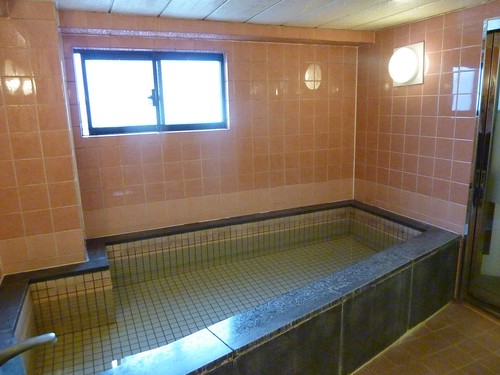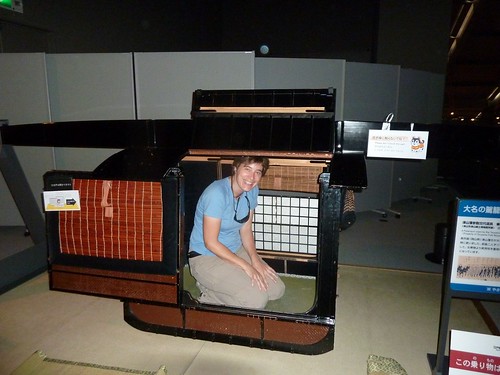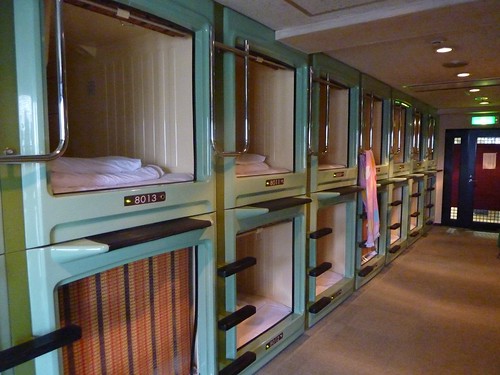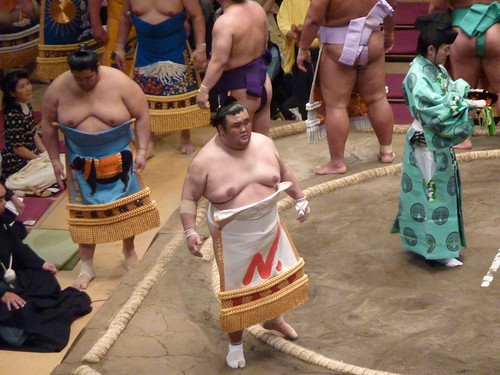I’m told that’s the nickname English speakers use for Tokyo - The Big Mikan. (Mikan means mandarin orange). So I’m here in the big city, the last overseas stop in a string of stops so long that people’s eyes glaze over when I’m asked to list them. And I’ve checked in to my last hotel room. The hotel room I’m in now, however, was not the first place I stayed in Tokyo. I decided that one of the things I needed to do in Japan was to stay in a capsule hotel, so I booked into a place at Asakusa (not to be confused with Akasaka…) and checked in when I got off the train from Takayama.
I’ll admit I had some preconceived notions about what the capsule hotel would be like. I imagined floor after floor of spotless, space-age capsules arranged with same-floor access to pleasant common areas and with communal toilets, showers and a bath close by. The capsules would be small but cozy, with tv, alarm clock, power outlets and maybe even internet. Spacious lockers would secure my belongings right next to my capsule. It would all be clean, efficient, aesthetically pleasing, and display one or two unforeseen but brilliant little bits of hospitality or technology, like sliding doors that would automatically open and close to seal off the capsule, making a whooshing Star Trek noise when they did. This is Japan, after all, I’ve come to expect nothing less.
Not surprisingly, I was mostly wrong. The capsule hotel I stayed in did have rooms spread over many floors, but it shared those floors with a bunch of other things. The place was generally run down, and the services were scattered all over. My capsule, #8021, was on the 8th floor, and shared the room with 23 others. There were toilets and sinks in the next room. Lockers were there too, but were awkwardly shaped, like interlocking Ls, I suppose to allow you to hang up clothing in the tall part. Large bags had to be left unsecured, or put in pay-as-you-go lockers on the 2nd floor. Luckily I was able to rearrange things to be able to fit everything important into my locker, but it was a bit of a pain.
There was a communal bath on the 9th floor, divided between men and women. The only showers were the ones next to the bath. They’re a particular sit-down type that you find at onsen all over Japan. And because I happened to have my camera with me when I was investigating, and there was no one using the place at the time, you get to have a look. You’d normally use these shower stations to wash yourself thoroughly before getting in the bath. I I’m used to having a shower in my room at other times, so maybe this is what communal showers are always like in Japan.
 And just because I can, here’s a look at the bath. It’s much more utilitarian than the ones I’ve had in nicer hotels.
And just because I can, here’s a look at the bath. It’s much more utilitarian than the ones I’ve had in nicer hotels.
There was wifi internet, but it was on the 2nd floor, along with a tv and a bit of a lounge area. The 9th floor had laundry machines, the baths, and a reasonable view over the river. And once I got over my initial disappointment at the decidedly non-Flash Gordon-like atmosphere, I realized that it did indeed have everything I needed. If I thought about it as a hostel with slightly more private bunks, then it all seemed pretty reasonable. And for ¥3,240 per night in Tokyo, you can’t really argue.
And the capsule itself? It was about 1 metre x 1 metre x 2 metres (one tatami mat), and had a very 1960s moulded plastic kind of flair. It did have a tv, though I didn’t bother with that because, like lots of TVs in hotel rooms in Japan, it had an impenetrable vending machine pay card system for viewing any channels other than those showing Japanese game shows. It also had a digital clock and a small shelf and a light with a dimmer switch. The opening could be covered with a rolling blind, and once I was ensconced for the night, it was pretty comfortable and cozy.
All in all, the capsule hotel wasn’t bad, but I was very happy to move to my “real” hotel the next day. It has a full-sized bed, desk, internet, balcony and a very very small kitchenette. It’s my last hotel room of the trip, and it is certainly worthy of that honour.
Once I’d safely moved hotels, it was time to actually see something of Tokyo. My first stop was the Edo museum, which was really excellent, giving a great overview of the history of Tokyo (which used to be called Edo) during some of the most interesting periods. Better still was the guide service that was offered. The LP indicated that English guides were available, and signage at the museum seemed to confirm this, so I presented myself at the guide desk and expected to be given a pamphlet, or, at best, an audio player. Instead, I was presented with a perky Japanese woman who was my personal guide for the next hour and a half. It was an outstanding service – all volunteer, and totally free. She took me through most of the displays, explaining things I wouldn’t have understood on my own, and even took a photo.
 Me in a traveling palanquin sort of thing
Me in a traveling palanquin sort of thing
I spent a very happy morning at the museum, had lunch, and then went back for a bit to see some of the exhibits I didn’t have time for with my guide. Then it was time for the other big event of the day, and when I say big, I mean BIG:
I was lucky enough to be in Tokyo during one the three grand sumo tournaments held each year, and when I realized this, and found out that I could get a walk-up ticket on Friday morning, I was there in a flash. (Well, actually I was there after a frustrating ride on the Tokyo subway, more on that later). The ticket was ¥2,100 for an all-day seat anywhere in the very last row of the very top balcony. The nice thing is that most of the people who attend these tournaments only come for the later matches of the day when the highest-ranked wrestlers are competing. This means that lots of good seats stay empty during the afternoon so it’s quite normal to camp out in a better seat than you’ve bought until someone with a real claim to it comes along. And that’s just what I did.
Sumo is fascinating, partly because it’s full of tradition. The matches take place in a ring called the dohyo, which is made out of straw rice bags arranged in a circle and then mostly covered with clay and dirt so that only a slight ridge is exposed. A new dohyo is constructed for each tournament. The one at the national sumo stadium also has a large roof structure suspended over the dohyo, meant to resemble a Shinto shrine. The rules of sumo are simple enough, the bout is one by the first rikishi (wrestler) who either forces his opponent to step out of the ring, or to touch any part of the dohyo with any part of his body other than the soles of his feet. Sometimes matches are over in seconds, sometimes they last a minute or two. Interestingly, there are no weight classes in sumo, so a small guy can be put up against a monstrous mountain of flesh, and that’s just his tough luck. These are the kind of matches the crowd really gets behind, but they usually end up the way you’d expect, with the little guy tossed out in short order.
What takes the most time is all the ceremony and posturing that goes on before the bout starts. There’s a lot of pomp involved, including the ceremonial arrival of the fighters in each division at the beginning of their day’s session. They parade in wearing nothing but their mawashi (the loin cloth/waist band thingy you’ve all seen) and an elaborate and colourful silk apron with rich embroidery and fringe (costing up to ¥500,000). And each bout is preceded by the sing-song announcement of each fighter’s name, performed by a specific person. There’s also lot of symbolic and aggressive posturing by the rikishi who, at the highest levels, are allowed to spend up to four minutes preparing for the match by getting set into the crouch position, glaring at each other, and then walking back to their corners for more ritual cleansing, scattering of salt in the ring, and general gamesmanship. This just gets everyone – the fighters and the crowd – more and more worked up before the initial clash.
And lucky you, you get to see some video of one of the sumo matches I saw. This is two of the higher ranked fighters, who came along later in the afternoon. They’ve just finished about four rounds of posturing, crouching, getting ready, walking away, slapping themselves, cleansing themselves, throwing salt, and generally trying to intimidate the other guy. (And look at that guy on the right, sitting down. He’s huge! I think they just classed him as a new planet…)
I really enjoying watching the sumo, partly because they had an excellent and informative English pamphlet available, which helped immensely. I spent a couple of hours there, wandering around the stadium, watching matches, reading my pamphlet, and just enjoying myself. It was a great afternoon.
I mentioned that I’ve had some trouble with the Tokyo metro system. It turns out that the Tokyo metro/subway/trains are a bit too Kuala Lumpur for my tastes. There are several different companies running trains around the city, and they don’t always play nicely together. For instance on the morning of sumo, I strode out confidently and bought a ticket from Asakusa station, planning to head to Ryogoko, just one change and two stops down the line. It turned out though, to be a case of you-can’t-get-there-from-here. I needed to be at a different Asakusa station, on a different line (Asakusa on the Asakusa line, not Asakusa on the Ginza line. Silly me). That station was a few blocks from where I started, and necessitated me buying another ticket. Then I got to the interchange station and discovered that Tokyo defines interchange in much the same way that Kuala Lumpur does meaning, it seems, that any station within a 1.5km radius of can be considered “connected” to the station you’re changing from. Considering that Japan is so very good at so very many things it’s odd to me that the transit system in the country’s largest city should be so… meh. People who live here tell me that once you get used to it it’s very efficient and you can get anywhere and blah blah blah… to which I say: Tell me that the next time you have to walk three blocks between the Asakusa line and the Odeo line in the pouring rain. And if it’s so easy, then why does everyone have some kind of application on their phone to help them navigate the system? I rest my case.
And how about a few more thoughts on vending machines? Remember how I mentioned that the TVs in hotel rooms require cards you get from a vending machine? The same thing was true when I went to buy laundry soap so I could do some washing at the capsule hotel. I managed to convey the idea of “laundry soap” to the mostly uni-lingual desk clerk (though of course he was a lot more bilingual than I was) and he kept pointing behind me and saying “30 yen”. I turned to where he was pointing and faced some kind of vending machine. It was covered in buttons labeled with Japanese characters, so I punched the one that said ¥30, shoveled in some money, and was rewarded with… no, not a packet of soap. I was rewarded with a tiny ticket. I turned 180 degrees, advanced one step and presented the ticket to the desk guy, and he presented me with a packet of soap. This seemed an oddly complicated system. Surely it would be simpler if I could have given the guy ¥30 and he could have given me the soap, and we could have eliminated the machine entirely. However, in retrospect I realized that by using a ticket machine like this for all kinds of odds and ends, the hotel managed to avoid having their staff handle any money. It’s actually kind of smart. (Hey wait a minute! They took my money when I paid for the capsule… so much for that argument.)
 Ticket vending machine outside the ramen restaurant where I had supper one night.
Ticket vending machine outside the ramen restaurant where I had supper one night.
So that was my first few days in Tokyo: capsules, vending machines, subway frustrations and sumo! And now I’ve had two solid days of rain, and am getting a bit frayed. It’s a cool city, but it’s less cool in the rain. Perhaps this is good though, because I’ve only got two days left and the rain is making me feel like that will be just fine. Two days. Too weird.







4 Comments:
Pam
I'm very sorry, but your vending machine for a ticket to give to the clerk for soap has me laughing big belly laughs. I can feel your fustration....
It's amazing that your worldly trip is almost over. My gosh what am I going to do, when you get home, and I won't have your blog to read. My life will be so dull. Thank you so much for sharing so much with us back here in the Peg... Marilyn Mouse
Two days left. Two days until I see you at the airport.
Wet or dry, you will be fine until then.
Enjoy the end of your trip.
rh
Fantastic, really interesting post. I'm sorry to have found your blog the day before your trip finishes really! The hotel seems very 'cosy'!
I agree with Marilyn, your blog is definitely a bright point in my daily routine of e-mail checking, thank you so much for sharing your adventures with all of us. Happy Journey back to North America.
Post a Comment